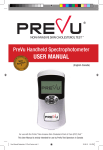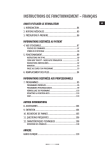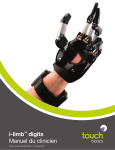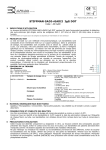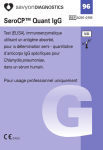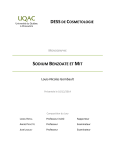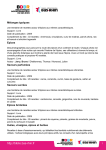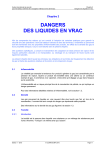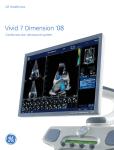Download english intended use summary and explanation of the test principle
Transcript
PRECAUTIONS 1. Dispense hanging drop of each reagent. In order to prevent contamination, do not touch dropper bottle nipple assembly to surface of skin. 2. Do not use kit components beyond expiry date and do not mix reagents from kits with different lot numbers. ENGLISH 3. Avoid exposure of reagents to excessive heat or light. INTENDED USE The PreVu® Non-Invasive Skin Cholesterol Point 4. Observe good laboratory practices, i.e., do not of Care (POC) Test (PreVu POC Test) is an in vitro eat, drink, smoke or apply cosmetics in areas diagnostic test for the quantification of skin where biological reagents are used. cholesterol. Like serum cholesterol, elevated skin 5. Bring reagents to room temperature (18-25°C or cholesterol is associated with an increased risk of 64-77°F) prior to testing. Return all reagents to coronary artery disease. Thus, skin cholesterol can be refrigerator after use. used as part of risk assessment for coronary artery disease (CAD). SUMMARY AND EXPLANATION OF THE TEST The assessment of skin cholesterol allows for the quantification of cholesterol present in the tissues. Skin contains approximately 11%, by weight, of all body cholesterol and has been cited as “mirroring” vascular changes associated with age and atherosclerosis1. A number of studies have demonstrated a relationship between skin cholesterol levels and CAD (reviewed in Lopukhin1) and more recently studies showing a relationship between skin cholesterol levels and treadmill stress test outcome2, and skin cholesterol correlated with angiographically proven CAD3 have been reported. The PreVu POC Test affords a practical and effective method of determining skin cholesterol. Skin cholesterol as measured by the PreVu POC Test can be used in conjunction with clinical evaluation and other lipoprotein tests as part of risk assessment for coronary artery disease. PRINCIPLE OF THE PROCEDURE The PreVu POC Test is a rapid two-step test for the detection of skin cholesterol. The test is performed on the palmar surface of the hand and requires no prior fasting. The principle of the procedure is as follows: 1. A solution (Detector) containing digitonin and horseradish peroxidase enzyme (HRP) conjugated to a copolymer is first placed on the palm of the hand for one minute. During this time, digitonin forms complexes with cholesterol in the skin. The greater the amount of cholesterol present in the epidermis, the greater the amount of Detector will attach. 2. Unbound Detector is blotted off the palm with a Blotting Stick. 3. A second solution, Indicator, is added to the test sites for two minutes. The Indicator is a substrate that reacts with HRP in the Detector to produce a blue-green colour. The greater the amount of Detector bound to skin cholesterol, the darker the colour will become. 4. A hand-held spectrophotometer is used to determine an epidermal skin cholesterol value by measuring the hue† of the colour developed in the test well. Negative and positive controls applied to the palm in parallel with the Detector solution serve as reagent and procedural controls to monitor test performance. MATERIALS Materials Supplied in the PreVu POC Test Kit (Contains 40 tests) Alcohol Swab Forty four (44) isopropyl alcohol (70% v/v) swabs Foam Pad Forty four (44) foam applicator pads with medicalgrade adhesive protected by a paper liner. Wet-Nap® moist towelette Forty four (44) pre-moistened hand cleaning wipes. Blotting Stick Forty four (44) blotting sticks (cellulose fibre rods). NOTE: Additional supply volumes provided for practice/unintentional wastage. Detector (green cap) One dropper bottle with 2.5 mL of digitonin horseradish peroxidase conjugate in StabilZyme SELECT® Stabilizer‡ as a buffer solution. Store refrigerated. Stable at 2-8°C (36-46°F) for duration of labelled expiry date. PC - Positive Control (red cap) One dropper bottle with 2.5 mL of digitonin horseradish peroxidase conjugate in StabilZyme SELECT® Stabilizer‡ as a buffer solution. Store refrigerated. Stable at 2-8°C (36-46°F) for duration of labelled expiry date. The PC solution is 10X more concentrated than the Detector solution. Indicator (blue cap) One dropper bottle with 6.0 mL of 3, 3’, 5, 5’– tetramethylbenzidine (TMB) – hydrogen peroxide solution. Store refrigerated. Stable at 2-8°C (36-46°F) for duration of labelled expiry date. Materials Required But Not Provided PreVu POC Handheld Spectrophotometer (PVU-SPECT-101-UNI) WARNINGS Methylisothiazolone warning: Methylisothiazolone in combination with methylchloroisothiazolinone (MI/MCI) is routinely used in the cosmetics industry as a biocide. MI/MCI has been reported to be slightly irritating to the skin at some concentrations. The PreVu POC Test reagents contain only 100ppm of MI and are not expected to cause skin irritation. However, use of the PreVu POC Test should be discontinued in individuals who experience skin irritation. NOTE: For External Use Only! STORAGE INSTRUCTIONS Store reagents between 2-8°C (36-46°F) for duration of labelled expiry date. 4. In the clinical studies supporting the PreVu POC Test safety and effectiveness only a small number of African American subjects were evaluated in relation to other patient subgroups. Consequently, use of the PreVu POC Test for risk assessment of CAD in African American subjects must be carefully considered with all other risk factors before any follow-up patient management decisions are made. 5. Consult the PreVu POC Handheld Spectrophotometer User Manual prior to use. NOTE: It is recommended to test the hypothenar eminence of the palm. INTERPRETATION OF RESULTS Skin cholesterol values less than 81 are below the detection limit of the PreVu POC Test. Individuals with skin cholesterol measurements equal to or below 134 are considered to be at normal risk of developing CAD, whereas those with skin cholesterol values greater than 134 are at increased risk (Table 1). TEST PROCEDURE Table 1. Skin Cholesterol Ranges and Interpretation Preparation for the Assay 1. Bring all reagents to room temperature (18-25°C or 64-77°F). 2. Activate the PreVu POC Handheld Spectrophotometer and consult User Manual. 3. Finish assay without interruption. Assay Procedure Follow test directions using the PreVu POC Handheld Spectrophotometer. 1. Hands must be clean prior to the test. Wash hands with soap and water or vigorously clean outside portion of palm of one hand with WetNap® moist towelette provided. Dry the palm using a clean paper towel or other absorbent, lint-free tissue. Then wipe the outside portion of the palm of the hand vigorously with an Alcohol Swab and wait about 30 seconds for the cleaned area to air dry. Discard Wet-Nap® moist towelette but save Alcohol Swab for use after test. NOTE: Do not use other brands of moist towelette to clean hands. 2. Air-dry palm. Palm must be completely dry before proceeding with the next step. 3. Remove adhesive backing from Foam Pad. Firmly place Foam Pad on alcohol-wiped portion of hand with the diamond well towards fingers. 4. Rest subject’s hand on flat surface. 5. Add one drop of Detector (green cap) to round test well. 6. Add one drop of PC (red cap) to diamond well. 7. Do not add any liquid to square well. 8. Wait 1 minute. 9. Slowly insert one end of the double-ended Blotting Stick into the round, centre well of the Foam Pad to absorb the Detector reagent. After insertion press firmly and hold for 3 seconds to ensure that all Detector reagent has been absorbed, then invert Stick and insert the second (clean) end into the same well (centre well) of the Foam Pad. Press to make firm contact and gently twist the Blotting Stick approximately one quarter of a turn forward and then back while still making contact with the palm. Once the centre well has been blotted dry, remove the Blotting Stick and slowly insert the second end into the diamond-shaped well to absorb the PC reagent. Discard the Blotting Stick. NOTE: Visually ensure that Foam Pad and test wells are completely dry. 10.Add one drop of Indicator (blue cap) to all wells, including the square well. 11.Wait two minutes. 12.Immediately read test well with the PreVu POC Handheld Spectrophotometer. Blot excess liquid and remove Foam Pad. Clean palm with Alcohol Swab from Step 1. Test Validity 1. Liquid in square well is colourless. 2. Liquid in diamond well is blue-green. Repeat test on other hand if assay is invalid. Consult Technical Service at 1-888-928-7205 (Canada) if assay fails the repeat test. CAD Risk Category <81 Below limit of detection Normal risk 81-134 Normal range of skin cholesterol Normal risk >134 Elevated skin cholesterol Increased risk Precision Table 2 shows the reproducibility of the PreVu POC Test within-day, between days, and from batch to batch. Table 2. Reproducibility of PreVu POC: Mean CV (range) WithinDay Day-toDay Low skin cholesterol 11% (5-19%) 8% (4-17%) High skin cholesterol 7% (2-13%) 3% (1-5%) a Batch-toBatcha 10% (1-17%) (Contains 40 tests) Skin cholesterol levels were measured using the PreVu POC Test, in 750 individuals at three angiography clinics (649 cases) and three out-patient facilities (101 controls). Skin cholesterol levels were significantly lower in control subjects compared to the case population (105 vs. 123, p<0.001). The distribution of controls and cases in the different skin cholesterol ranges is shown below (Table 3). Table 3. Distribution of Controls and Angiography Clinic Patients by Skin Cholesterol Range Skin Cholesterol Range Controls (n=101) Angiography Patients (n=649) <81 12% (n=12) 10% (n=62) 81-134 79% (n=80) 56% (n=363) >134 9% (n=9) 34% (n=224) Table 4 shows the relationship between skin cholesterol and CAD as determined by coronary angiography. Skin cholesterol was correlated with CAD even after adjusting for Framingham risk factors. The strongest relationship was with multi-vessel disease. This shows that skin cholesterol provides new information about CAD risk that is independent of Framingham risk factors: age, gender, serum LDL, serum HDL, hypertension status, diabetes status, and smoking status. Table 4. Relationship Between Skin Cholesterol and CAD Determined by Coronary Angiography (odds ratio, 95% confidence interval, p-value) Parameter Insignificant CADa Any CADb MultiVessel CADc Skin 1.06 1.07 1.08 cholesterol (0.99-1.12) (1.01-1.13) (1.03-1.14) (10 unit 0.06 0.02 0.004 increase) Skin cholesterol 1.05 1.06 1.08 Adjustedd (0.99-1.12) (1.01-1.13) (1.02-1.15) (10 unit 0.13 0.03 0.009 increase) a † All colours can be characterized by hue (the dominant shade), saturation (how much colour of any hue is present) and lightness (the degree of lightness or darkness of a particular colour) in a three-dimensional space using cylindrical coordinates. Lightness is the centre vertical axis and saturation is the horizontal axis that extends from the lightness axis. Hue is the angle at which the saturation axis extends from the lightness axis. ‡ StabilZyme SELECT® is an aqueous solution containing a purified bovine protein and other non-toxic stabilizing chemicals in MOPS (3-(N-Morpholino) propanesulfonic acid), pH 6.2-6.7, buffer. The solution is preserved with the following components: 0.02% methylisothiazolone, 0.02% bromonitrodioxane and 20 ppm Proclin 300 (Rohm and Haas Company). KIT CONTENTS 3 lots of PreVu POC were compared CLINICAL DATA Instrument Calibration LIMITATIONS OF THE PROCEDURE Interpretation SPECIFIC PERFORMANCE CHARACTERISTICS QUALITY CONTROL PROCEDURES When using the PreVu POC Handheld Spectrophotometer, the instrument must be calibrated prior to each test. The instrument will prompt the operator to open the alignment shoe completely and leave it open until a beep is heard. If you have a tethered version of the spectrophotometer please consult the instructions provided with that device for the proper calibration procedure. The instrument will then indicate whether calibration was successful. If calibration was not successful, the instrument will indicate to repeat the calibration procedure. If the calibration error persists, please refer to the User Manual. Skin Cholesterol Range 3. Sprecher DL, et al. Skin Tissue Cholesterol (Skin Tc) is related to angiographically-defined cardiovascular disease. Atherosclerosis 2003; 171:255-258. There are no conditions, warranties or representations, expressed or implied, statutory or otherwise, made by Miraculins Inc., its officers, agents or distributors, regarding the performance of this kit when: 1. the validated test procedure described in this package insert is not followed, 2. the kit components are used beyond the indicated expiry date, or 3. components of different lot numbers are mixed, whether such components are purchased individually or as part of a kit. Patent Information The PreVu Non-Invasive Skin Cholesterol test technology is protected by patents and patents pending in North America and Internationally. Questions? 1-888-928-7205 (Canada) www.prevu.com Manufactured By: EC Rep: Miraculins Inc. Emergo Europe 6-1250 Waverley Street Molenstraat 15 Winnipeg, Manitoba 2513 BH The Hague Canada R3T 6C6 The Netherlands Manufactured for Miraculins by Fisher Diagnostics, part of Thermo Fisher Scientific. PreVu® is a registered trademark of Miraculins Inc. All rights reserved. 2012. ≤ 50% stenosis in any coronary arteries b 1. The wells in the Foam Pad must not be placed >50% stenosis in at least one coronary artery c over prominent creases on the palm as this >50% stenosis in more than one coronary artery d may allow the liquid to leak from the wells adjusted for Framingham Global Risk and trial site during incubation. 2. Patients using topical medications and individuals REFERENCES with skin disease (e.g. eczema, psoriasis) on the 1. Lopukhin YuM. The skin and atherosclerosis hands should not be tested. (a three-drop test). Physiochemical Aspects of Medicine Reviews. 1992; 3:1-124. 3. Patients who have recently used a dermatological preparation, such as a hand lotion or barrier 2. Zawydiwski R, Sprecher DL, Evelegh MJ, cream, may produce aberrant skin et al. Cholesterol 1,2,3™: A novel test for the cholesterol values. determination of skin cholesterol levels. Clinical Chemistry 2001; 47:1302-1304. 1. 2. 3. 4. 5. 6. 7. 44 Alcohol Swabs – for external use only! 44 Foam Pads 44 Wet-Nap® moist towelettes 44 Blotting Sticks Detector Solution (2.5 mL) PC (This is the positive control solution) (2.5 mL) Indicator Solution (6.0 mL) NOTE: Additional supply volumes provided for practice/unintentional wastage. SYMBOL LEGEND : Contains N Tests : Store at : Expiration Date : Lot # : Manufacturer : In Vitro Diagnostic : See instructions : European Conformity FRANÇAIS UTILISATION VISÉE Le test de cholestérol cutané non invasif PreVu® Point of Care (POC) (test PreVu POC) est un test diagnostique in vitro administré dans le but de mesurer le cholestérol cutané. À l’instar du cholestérol sanguin, les taux élevés de cholestérol cutané sont associés au risque accru de coronaropathies. En conséquence, il est possible d’utiliser le test de cholestérol cutané pour évaluer le risque de coronaropathies. RÉSUMÉ ET EXPLICATION DU TEST L’évaluation du cholestérol cutané permet de quantifier le cholestérol présent dans les tissus. La peau contient environ 11 % du cholestérol de l’organisme, si on le mesure par le poids. On semble croire que le cholestérol cutané reflète les changements vasculaires liés à l’âge et à l’athérosclérose1. Un bon nombre d’études montrent un rapport entre les taux de cholestérol cutané et les coronaropathies (étude de Lopukhin1). Des expertises plus récentes soulignent un rapport entre les taux de cholestérol cutané et les résultats des épreuves d’effort sur tapis roulant2. En outre, une corrélation entre le cholestérol cutané et les coronaropathies confirmées par angiographie3 a été signalée. Le test PreVu POC offre une méthode d’évaluation pratique et efficace du taux de cholestérol cutané. On peut utiliser les résultats du test PreVu POC en association avec des évaluations cliniques et d’autres épreuves de lipoprotéines pour mesurer le risque de coronaropathies. PRINCIPES DE BASE DU TEST Le test PreVu POC est une évaluation rapide en deux étapes qui vise à détecter le taux de cholestérol cutané. Ce test, pratiqué sur la paume de la main, n’exige pas que le patient se présente à jeun. En voici les principes de base : 1. La solution Detector, qui contient de la digitonine et de la peroxydase de raifort conjuguées à un copolymère, est tout d’abord placée dans la paume de la main pendant une minute. En l’occurrence, la digitonine forme des complexes avec le cholestérol cutané. Plus le degré de cholestérol présent dans l’épiderme est accentué, plus la liaison avec la solution Detector sera considérable. 2. À l’aide d’un bâtonnet absorbant, enlever la solution non liée présente à la surface de la paume. 3. Ajouter ensuite une seconde solution, appelée Indicator, aux sites de l’épreuve pendant deux minutes. La solution Indicator est un substrat qui réagit à la peroxydase de raifort présente dans la solution Detector. La solution Indicator produit une teinte bleu-vert. Plus la liaison de la solution Detector avec le cholestérol cutané est considérable, plus la teinte sera foncée. 4. Le taux de cholestérol de l’épiderme s’obtient à l’aide d’un spectrophotomètre manuel qui mesure l’intensité de la teinte† de la solution Detector dans le puits d’essai. Les solutions témoin négatives et positives qui sont appliquées dans la paume, en parallèle avec la solution Detector, servent de réactifs biologiques et de solutions témoin pour évaluer la performance du test. MATÉRIEL POUR LE TEST : (Contient 40 tests) Composition de la trousse du test PreVu POC Tampon d’alcool Quarante-quatre (44) tampons d’alcool isopropylique (70 % v/v). Tampon mousse Quarante-quatre (44) tampons mousse recouverts d’un adhésif de qualité médicale doublé d’un papier de protection. Lingettes Wet-Nap ® Quarante-quatre (44) lingettes pré-humidifiées pour se nettoyer les mains. Bâtonnets absorbants Quarante-quatre (44) bâtonnets absorbants (tiges en fibre de cellulose). REMARQUE : Matériel supplémentaire fourni pour procéder à des essais/pallier tout gaspillage accidentel. Solution Detector (capuchon vert) Un flacon compte-gouttes contenant 2,5 ml de digitonine / peroxydase de raifort conjuguées dans la solution stabilisante StabilZyme SELECT®‡ pour maintenir la constance du pH. Conserver au réfrigérateur. Sa stabilité se maintient entre 2 °C et 8 °C (36 °F et 46 °F) jusqu’à la date de péremption indiquée sur l’étiquette. Solution témoin positive (PC) (capuchon rouge) Un flacon compte-gouttes contenant 2,5 ml de digitonine / peroxydase de raifort conjuguées dans la solution stabilisante StabilZyme SELECT®‡ pour maintenir la constance du pH. Conserver au réfrigérateur. Sa stabilité se maintient entre 2 °C et 8 °C (36 °F et 46 °F) jusqu’à la date de péremption indiquée sur l’étiquette. La solution PC est dix fois plus concentrée que la solution Detector. Solution Indicator (capuchon bleu) Un flacon compte-gouttes contenant 6,0 ml de tétraméthyl-3,3’, 5,5’ benzidine – eau oxygénée. Conserver au réfrigérateur. Sa stabilité se maintient entre 2 °C et 8 °C (36 °F et 46 °F) jusqu’à la date de péremption indiquée sur l’étiquette. Matériel nécessaire non fourni Spectrophotomètre manuel PreVu POC (PVU-SPECT-101-UNI) AVERTISSEMENTS Avis sur le méthylisothiazolone : En temps normal, l’association méthylisothiazolone (MIT) et méthylchloroisothiazolinone (MCI) est utilisée dans les produits cosmétiques comme biocide. On signale que certaines concentrations de l’association MIT / MCI peuvent provoquer de légères irritations de la peau. Les réactifs du test PreVu POC contiennent seulement 100 ppm de MIT et ne sont pas censés provoquer d’irritations cutanées. Toutefois, l’utilisation du test PreVu POC devrait cesser en présence d’irritations cutanées. REMARQUE : Usage externe seulement! MISES EN GARDE 1. Administrer une goutte de chaque réactif. Pour prévenir la contamination, l’embout du flacon compte-gouttes ne doit pas entrer en contact avec la surface cutanée. 2. On ne doit pas utiliser les articles de la trousse au-delà de la date de péremption, ni mélanger les réactifs avec ceux provenant de trousses dont le numéro de lot est différent. 3. Éviter d’exposer les réactifs aux excès de chaleur ou de lumière. 4. Observer les bonnes pratiques de laboratoire : ne pas manger, ni boire, ni fumer, ni se maquiller dans des zones où sont utilisés des réactifs biologiques. 5. Avant d’administrer le test, amener tous les réactifs à la température ambiante (18 °C à 25 °C ou 64 °F à 77 °F). Remettre tous les réactifs au réfrigérateur après l’administration du test. CONSERVATION Conserver les réactifs entre 2 °C et 8 °C (36 °F et 46 °F) jusqu’à la date de péremption indiquée sur l’étiquette. DÉROULEMENT DU TEST Préparation du dosage biologique 1. Amener tous les réactifs à la température ambiante (18 °C à 25 °C ou 64 °F à 77 °F). 2. Activer le spectrophotomètre manuel PreVu POC et consulter le manuel d’utilisation. 3. Pratiquer le dosage biologique sans interruption. Dosage biologique Suivre les directives à l’aide du spectrophotomètre manuel PreVu POC. 1. Les mains doivent être propres avant d’administrer le test. Se laver les mains avec du savon et de l’eau ou nettoyer énergiquement la surface externe de la paume d’une main avec la lingette Wet-Nap® fournie. Sécher la paume de la main à l’aide d’un essuie-tout propre ou d’un autre papier absorbant non pelucheux. Frotter ensuite énergiquement la surface externe de la paume de la main avec un tampon d’alcool et laisser sécher la surface nettoyée à l’air pendant environ 30 secondes. Jeter la lingette Wet-Nap®, mais conserver le tampon d’alcool pour l’utiliser après le test. REMARQUE : Ne pas utiliser d’autres marques de lingettes pour se laver les mains. 2. Laisser sécher la paume de la main à l’air. La paume doit être complètement sèche avant de passer à l’étape suivante. 3. Retirer le papier de protection du tampon mousse et poser le tampon mousse fermement sur la partie de la main essuyée à l’alcool. Le puits diamanté doit être placé en direction des doigts. 4. Laisser reposer la main du patient sur une surface plane. 5. Ajouter une goutte de la solution Detector (capuchon vert) au puits d’essai rond. 6. Ajouter une goutte de la solution PC (capuchon rouge) au puits diamanté. 7. Il ne faut pas ajouter de liquide au puits carré. 8. Attendre une minute. 9. Insérer lentement l’une des deux extrémités du bâtonnet absorbant dans le puits rond central du tampon mousse pour absorber le réactif Detector. Après l’insertion, appuyer fermement et maintenir pendant trois secondes pour s’assurer que tout le réactif Detector a été absorbé, puis inverser le bâtonnet absorbant et insérer la seconde extrémité (propre) dans le même puits (puits central) du tampon mousse. Appuyer pour établir un contact ferme et tourner légèrement le bâtonnet absorbant d’un quart de tour environ vers l’avant, puis vers l’arrière, tout en le laissant en contact avec la paume. Après avoir séché le puits central avec le bâtonnet absorbant, retirer le bâtonnet et insérer lentement la seconde extrémité dans le puits en forme de diamant pour absorber le réactif PC. Jeter le bâtonnet absorbant. REMARQUE : Vérifier visuellement que le tampon mousse et les puits de test sont complètement secs. 10.Ajouter une goutte de la solution Indicator (capuchon bleu) à tous les puits d’essai, y compris le puits carré. 11.Attendre deux minutes. 12.À l’aide du spectrophotomètre manuel PreVu POC, procéder immédiatement à la lecture du puits d’essai. Assécher l’excès de liquide et retirer le tampon mousse. Nettoyer la paume de la main à l’aide d’un tampon d’alcool en se référant à l’étape 1. Critères de validation des analyses 1. Le liquide du puits d’essai carré devrait être incolore. 2. Le liquide du puits d’essai diamanté devrait être bleu-vert. En cas de résultats invalides, répéter le test sur l’autre main. Consulter le Service d’assistance technique au 1 888 928-7205 (Canada) si le test ne réussit pas la deuxième fois. CONTRÔLE DE LA QUALITÉ Étalonnage de l’instrument Lorsque le spectrophotomètre manuel PreVu POC est utilisé, l’instrument doit être étalonné avant chaque test. L’instrument invitera l’opérateur à ouvrir à fond le sabot d’alignement et à le laisser ouvert jusqu’à l’audition du signal sonore. Si vous êtes doté d’un spectrophotomètre fixe, consulter les directives qui accompagnent l’instrument pour connaître la procédure d’étalonnage adéquate. L’instrument indiquera ensuite si l’étalonnage a réussi. En cas d’échec de l’étalonnage, l’instrument demandera de répéter la procédure d’étalonnage. Si l’erreur d’étalonnage persiste, consulter le manuel d’utilisation. LIMITES DU TEST 1. Les puits d’essai des tampons mousse ne doivent pas être placés sur les plis dominants de la paume de la main, car ceci pourrait provoquer des fuites de liquide pendant la période d’incubation. 2. Les patients qui utilisent des médicaments topiques ou qui souffrent de troubles cutanés des mains (p. ex. eczéma, psoriasis) ne doivent pas être soumis à ce test. 3. Les patients ayant utilisé récemment une préparation dermatologique, comme une lotion pour les mains ou une crème protectrice, risquent de présenter un score de cholestérol cutané fautif. 4. Parmi les études cliniques qui corroborent le profil d’innocuité et d’efficacité du test PreVu POC, seul un petit nombre de sujets américains de race noire ont été évalués par rapport à d’autres sous-groupes de patients. Par conséquent, si on envisage d’utiliser le test PreVu POC pour mesurer le risque de coronaropathies chez les sujets afro-américains, il importe de tenir compte de tous les autres facteurs de risque avant de pouvoir prendre des décisions concernant la mise en route d’un suivi thérapeutique. 5. Avant d’utiliser le spectrophotomètre manuel PreVu POC, consulter le manuel d’utilisation. REMARQUE : On recommande de tester l’éminence hypothénar (saillie arrondie de la paume de la main). INTERPRÉTATION DES RÉSULTATS Un score de cholestérol cutané inférieur à 81 est en deçà du seuil de détection établi par le test PreVu POC. On considère que les patients dont le score de cholestérol cutané est égal ou inférieur à 134 présentent un risque normal de coronaropathies, tandis que ceux qui ont un score supérieur à 134 sont à plus grand risque (Tableau 1). Tableau 1. Scores de cholestérol cutané et interprétation Score de cholestérol cutané Catégorie de risque de coronaropathies Interprétation <81 En deçà du seuil de détection Risque normal 81-134 Taux normal de cholestérol cutané Risque normal >134 Taux élevé de cholestérol cutané Risque accru CARACTÉRISTIQUES PRÉCISES DE LA PERFORMANCE Précision Le Tableau 2 illustre la reproductibilité du test PreVu POC, sous les rubriques « même jour », « d’un jour à l’autre » et « d’un lot à l’autre ». Tableau 2. Reproductibilité du test PreVu POC : CV moyen (score) Même jour Entre jours Faible cholestérol cutané 11 % (5-19 %) 8% (4-17 %) Cholestérol cutané élevé 7% (2-13 %) 3% (1-5 %) a Entre lotsa 10 % (1-17 %) Comparaison de trois lots de test PreVu POC DONNÉES CLINIQUES Les taux de cholestérol cutané ont été déterminés à l’aide du test PreVu POC chez 750 patients répartis dans trois cliniques qui pratiquent l’angiographie (649 cas) et dans trois établissements réservés aux consultations externes (101 témoins). Les taux de cholestérol cutané étaient sensiblement plus faibles chez les sujets témoins comparativement aux cas (105 par rapport à 123, p <0,001). La répartition des sujets témoins et des cas entre les différents scores de cholestérol cutané est présentée ci-dessous (Tableau 3). Tableau 3. Répartition des sujets témoins et des cas confirmés par angiographie selon le score de cholestérol cutané Score de cholestérol cutané Sujets témoins (n=101) Patients ayant subi une angiographie (n=649) <81 12 % (n=12) 10 % (n=62) 81-134 79 % (n=80) 56 % (n=363) >134 9 % (n=9) 34 % (n=224) Le Tableau 4 décrit le rapport entre le cholestérol cutané et les coronaropathies confirmées par angiographie. Le cholestérol cutané a été corrélé avec les coronaropathies, même après l’ajustement des facteurs de risque d’après le modèle de Framingham. Les atteintes polyvasculaires articulent davantage ce rapport. Cela démontre que le cholestérol cutané permet d’obtenir de nouveaux renseignements sur le risque de coronaropathies qui sont indépendants des facteurs de risque de Framingham, soit l’âge, le sexe du patient, le taux LDL, le taux HDL, l’hypertension, le diabète et le tabagisme. Tableau 4. Lien entre le cholestérol cutané et les coronaropathies confirmées par angiographie (ratio d’incidence approché, intervalle de confiance de 95 %, valeur prédictive) Paramètre Coronaropathies négligeablesa Aucune coronaropathieb Coronaropathies polyvasculairesc Cholestérol cutané 1,06 1,07 1,08 (augmen- (0,99-1,12) (1,01-1,13) (1,03-1,14) tation de 0,06 0,02 0,004 10 unités) Cholestérol cutané 1,05 1,06 1,08 ajustéd (1,01-1,13) (1,02-1,15) (augmen- (0,99-1,12) 0,13 0,03 0,009 tation de 10 unités) Sténose ≤ 50 % d’aucune artère coronaire Sténose > 50 % d’au moins une artère coronaire c Sténose > 50 % de plus d’une artère coronaire d Ajustement des facteurs de risque globaux d’après le modèle de Framingham et le site d’essai a b RÉFÉRENCES 1. Lopukhin YuM. The skin and atherosclerosis (a three-drop test). Physiochemical Aspects of Medicine Reviews. 1992; 3:1-124. 2. Zawydiwski R, Sprecher DL, Evelegh MJ, et coll. Cholesterol 1,2,3™: A novel test for the determination of skin cholesterol levels. Clinical Chemistry 2001; 47:1302-1304. 3. Sprecher DL, et coll. Skin Tissue Cholesterol (Skin Tc) is related to angiographically-defined cardiovascular disease. Atherosclerosis 2003; 171:255-258. Miraculins Inc., ses représentants, agents ou distributeurs ne s’engagent à aucune condition, garantie ni représentation, expresse ou implicite, réglementaire ou autre, en ce qui concerne la performance de la présente trousse si : 1. le test n’est pas réalisé selon les directives validées décrites dans le présent encart; 2. les articles de cette trousse sont utilisés postérieurement à la date de péremption indiquée sur l’étiquette de la trousse; ou 3. des composants chimiques provenant d’autres lots sont incorporés à ceux de la présente trousse, qu’ils aient été acquis individuellement ou qu’ils proviennent d’autres trousses. Renseignements sur les brevets : La technologie utilisée pour le test de cholestérol cutané non invasif PreVu bénéficie d’une protection conférée par des brevets et des brevets en instance en Amérique du Nord et à l’échelle internationale. Questions? 1-866-928-7205 (Canada) www.prevu.com Représentant UE : Fabriqué par : Emergo Europe Miraculins Inc. 6-1250 Waverley Street Molenstraat 15 2513 BH La Haye Winnipeg, Manitoba Pays-Bas Canada R3T 6C6 Fabriqué pour Miraculins par Fisher Diagnostics, une marque de Thermo Fisher Scientific. PreVu® est une marque déposée de Miraculins Inc. Tous droits réservés. 2012. † Toutes les couleurs se caractérisent par la teinte (le ton dominant), la saturation (le degré d’intensité d’une couleur) et la clarté (le degré de clarté ou d’obscurité d’une couleur) dans un espace à trois dimensions à l’aide de coordonnées cylindriques. La clarté est l’axe vertical central tandis que la saturation est l’axe horizontal qui s’étend à partir de l’axe vertical. La teinte est l’angle vers lequel se prolonge l’axe horizontal partant de l’axe vertical. ‡ StabilZyme SELECT® est une solution aqueuse qui contient de la protéine bovine purifiée et d’autres substances chimiques stabilisantes non toxiques dans une base d’acide-3-(NMorpholino) propane sulfonique pour maintenir la constance du pH de 6,2 à 6,7. Les composantes suivantes en assurent la conservation : 0,02 % de méthylisothiazolone, 0,02 % de bromonitrodioxane et 20 ppm de Proclin 300 (Rohm and Haas Company). CONTENU DE LA TROUSSE (Contient 40 tests) 1. 2. 3. 4. 5. 6. 7. 44 tampons d’alcool – usage externe seulement! 44 tampons mousse 44 lingettes Wet-Nap® 44 bâtonnets absorbants Solution Detector (2,5 ml) Solution PC (solution témoin positive) (2,5 ml) Solution Indicator (6,0 ml) REMARQUE : Matériel supplémentaire fourni pour procéder à des essais/pallier tout gaspillage accidentel. LÉGENDE : Contient N tests : Conserver à : Date de péremption : Lot no : Fabricant : Diagnostic in vitro : Voir les directives : Conformité européenne Issue date: January 2012 Date d’émission : janvier 2012 JL840747


